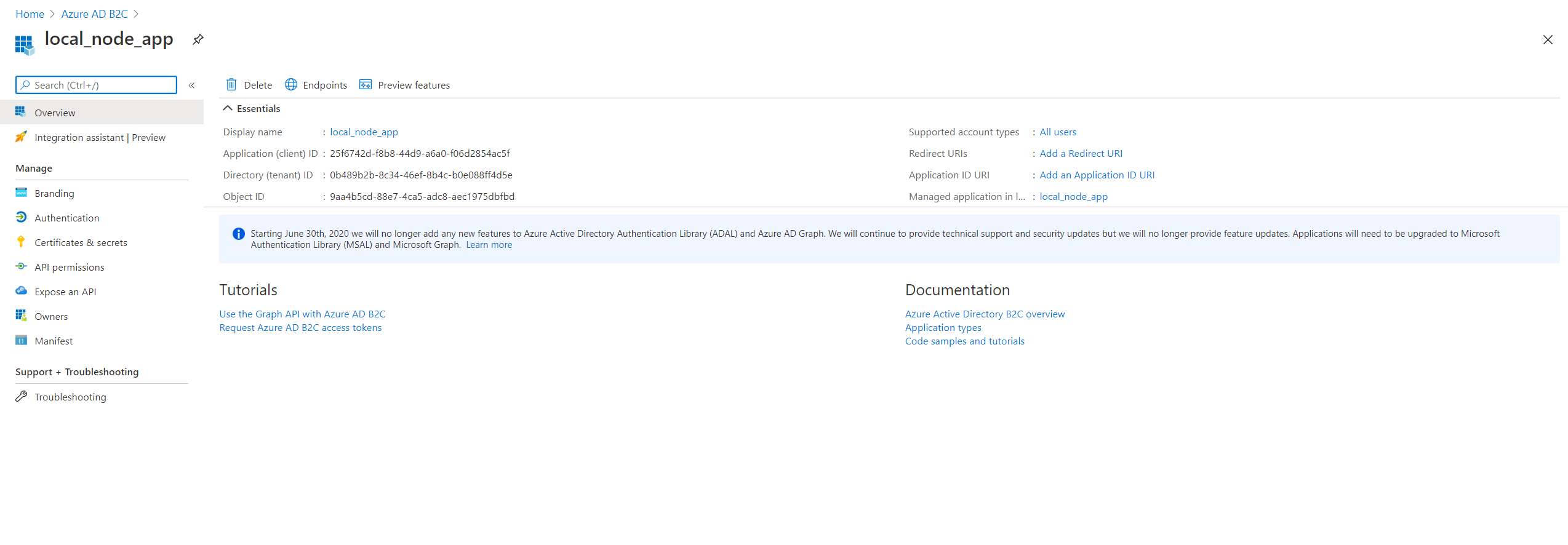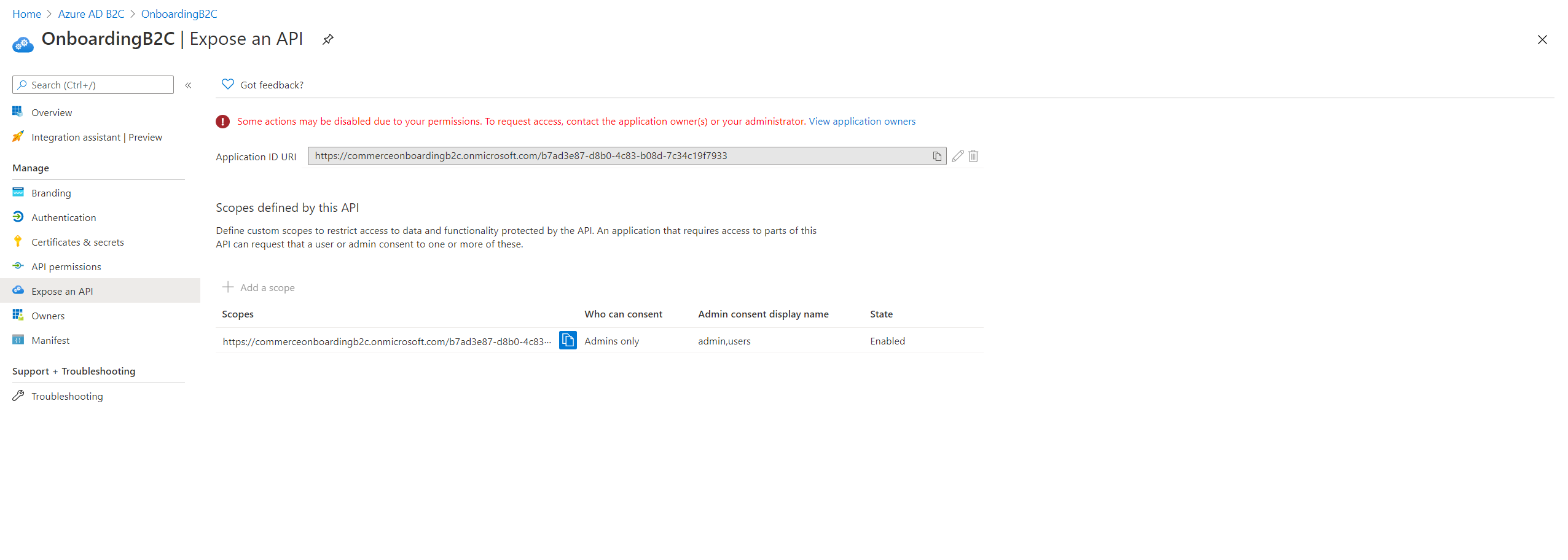Mock the signed-in state during local development
This article describes how to mock a signed-in user in a Dynamics 365 Commerce online local development environment.
Over the course of developing your e-Commerce online site, it may become necessary to develop and test scenarios for signed-in users. Rather than publish these pages and test against live pages, you can instead mock the signed-in state when running in developer mode.
Configure your Microsoft Entra B2C tenant
To take advantage of this feature, you must perform a one-time setup in your Microsoft Entra business-to-consumer (B2C) tenant to allow you to mock the signed-in user status. To proceed with the following steps, you will need to be signed in as a user with global administrator privileges.
Create a new resource owner password credentials (ROPC) flow
The first step is to create a new resource owner password credentials (ROPC) flow in your Microsoft Entra B2C tenant.
To create a new ROPC flow, follow these steps.
- Sign in to the Azure portal as the global administrator of your Microsoft Entra B2C tenant, and then select the Microsoft Entra B2C service.
- Select User flows and New user flow.
- Select Sign in using resource owner password credentials (ROPC), and then select Create.
- Enter a name for the user flow, for example "ROPC_Auth". Copy and save the full name, as it will be used later as the
ropcUserFlowNamevalue in your credentials.json file. - Under Application claims, select Show more.
- Select the following application claims:
- Display Name
- Email Addresses
- Given Name
- Identity provider
- SurName
- User’s object ID
- Select OK, and then select Create.
- Select the new user flow, and then select Run user flow.
You have now created a new ROPC policy to enable local sign-in. Under Run user flow you should see an endpoint URL similar to https://<LOGIN_DOMAIN>//<B2C_TENANT>.onmicrosoft.com/v2.0/.well-known/openid-configuration?p=B2C_1_ROPC_Auth. Take note of the <LOGIN_DOMAIN> and <B2C_TENANT> values from the URL, because this information will be used later in your credentials.json file.
In the following example image, the endpoint URL listed under Run user flow is https://commerceonboardingb2c.b2clogin.com/commerceonboardingb2c.onmicrosoft.com/v2.0/.well-known/openid-configuration?p=B2C_1_ROPC_Auth.

From the example above, you can obtain values for the ropcUserFlowName, loginDomain, and b2cTenant properties as follows:
| Property name | Example value |
|---|---|
| ropcFlowUserName | B2C_1_ROPC_Auth |
| loginDomain | commerceonboardingb2c.b2clogin.com |
| b2cTenant | commerceonboardingb2c |
Create a native application
Next, you will create a native application meant to represent the Node application you will run during local development.
In the Microsoft Entra B2C settings, select App Registrations, and then select New registration.
Enter a name for the application, for example "local_node_app".
For Supported account types, select Accounts in any identity provider or organizational directory (for authenticating users with user flows).
For Redirect URIs, select Public client/native (mobile & desktop) from the drop-down list, and leave the URI as is.
Leave all other default values as is, and select Register.
Select the new application, and then copy and save the Application (client) ID value, as this ID will be used later as the
nativeApplicationIdproperty value in your credentials.json file.
In the left navigation pane under Manage, select Authentication.
Select Try out the new experience (if shown).
Under Default client type, select Yes for Treat the application as a public client. This setting is required for the ROPC flow.
Select Save.
In the left navigation pane under Manage, select Manifest to open the manifest editor.
Set the oauth2AllowImplicitFlow attribute to true, and then select Save.

You have now created a new native application that will be used to represent your local Node application.
From the examples above, you have now obtained the following information:
| Property name | Example value |
|---|---|
| ropcFlowUserName | B2C_1_ROPC_Auth |
| loginDomain | commerceonboardingb2c.b2clogin.com |
| b2cTenant | commerceonboardingb2c |
| nativeApplicationId | 25f6742d-f8b8-44d9-a6a0-f06d2854ac5f |
Configure scope and register the native application
In the Microsoft Entra B2C settings, go to App registrations.
Open the application that is currently being used by the e-commerce rendering application. In the Azure portal, this is the application whose client ID is used in the Microsoft Entra B2C configuration for your site. If Microsoft Entra ID B2C is already configured, the application ID used for your e-commerce site can be found in Commerce headquarters at Commerce Shared Parameters > Identity Providers in the ClientId field under Relying Parties. The application ID can also be found in Commerce site builder at Tenant Settings > B2C Settings as the Client GUID within the B2C application configuration used for your site.
In the left navigation pane under Manage, select Expose an API and verify that a user_impersonation scope exists. If one does not exist, select Add a scope to create one. When prompted for an Application ID URI, leave the application ID URI as is and then add "user_impersonation" for the Scope name. Then enter friendly values for Admin consent display name and Admin consent description.

Copy and save the full scope value, as this information will be used late as the
userImpersonationScopeURLproperty value in your credentials.json file.Return to the native application you just created, and in the left navigation pane under Manage, select API permissions.
Select Add a permission, and then select the APIs my organization uses tab.
Search for your e-Commerce rendering application that was created above, and then select it and add user_impersonation as a permission.

Select Add permissions.
Select Grant admin consent for (this name will contain your domain), and then select Yes to apply the consent. You should now see a green checkmark under Status for user_impersonation.
The Microsoft Entra setup portion is now complete and you should now have your versions of all of the following example values.
| Property name | Example value |
|---|---|
| ropcFlowUserName | B2C_1_ROPC_Auth |
| loginDomain | commerceonboardingb2c.b2clogin.com |
| b2cTenant | commerceonboardingb2c |
| nativeApplicationId | 25f6742d-f8b8-44d9-a6a0-f06d2854ac5f |
| userImpersonationScopeURL | https://commerceonboardingb2c.onmicrosoft.com/b7ad3e87-d8b0-4c83-b08d-7c34c19f7933/user_impersonation |
Configure your Node application
After you have completed the steps to configure you Microsoft Entra B2C tenant, you will need to create a credentials file in your online software development kit (SDK) Node application.
The credentials will live under the secrets/ directory in your Node application. Create a secrets/ directory in your application if you haven't already, and then create a new file named credentials.json that is similar to the following example that uses the data gathered above.
{
"loginDomain": "commerceonboardingb2c.b2clogin.com",
"b2cTenant": "commerceonboardingb2c",
"nativeApplicationId": "25f6742d-f8b8-44d9-a6a0-f06d2854ac5f",
"ropcUserFlowName": "B2C_1_ROPC_Auth",
"userImpersonationScopeURL": "https://commerceonboardingb2c.onmicrosoft.com/b7ad3e87-d8b0-4c83-b08d-7c34c19f7933/user_impersonation",
"defaultUser": {
"name": "default",
"email": "",
"password": "",
"customerAccountNumber": ""
},
"additionalUsers":[
{
"name": "test-user-1",
"email": "test-user-1@example.com",
"password": "password",
"customerAccountNumber": ""
}
]
}

Note
Everything under the secrets/ directory should be added to your .gitignore file to help prevent credentials from being leaked online.
After using the information collected in the Azure setup steps to populate your credentials.json file, you need to add test accounts that you want to use during local development. The accounts defined here should be valid accounts that have already been created in Dynamics 365 Commerce headquarters.
- defaultUser: The default user that will be used when the mockUser query parameter is set to true. The name value should be default.
- additionalUsers: An array of user objects that allows you to configure additional users to test with. Each entry in this array should be an object with a name, email address, password, and customer account number. To sign in as one of these users, use the query parameter mockUser=<name>.
Mock a signed-in B2B user
If you need to mock a signed-in business-to-business (B2B) user, you can use the isB2bUser property for a user credential and set it to true, as shown in the following example.
{
"loginDomain": "commerceonboardingb2c.b2clogin.com",
"b2cTenant": "commerceonboardingb2c",
"nativeApplicationId": "25f6742d-f8b8-44d9-a6a0-f06d2854ac5f",
"ropcUserFlowName": "B2C_1_ROPC_Auth",
"userImpersonationScopeURL": "https://commerceonboardingb2c.onmicrosoft.com/b7ad3e87-d8b0-4c83-b08d-7c34c19f7933/user_impersonation",
"defaultUser": {
"name": "default",
"email": "",
"password": "",
"customerAccountNumber": "",
"isB2bUser": true
},
"additionalUsers":[
{
"name": "test-user-1",
"email": "test-user-1@example.com",
"password": "password",
"customerAccountNumber": ""
}
]
}
Mock sign-in status
After all of the above configuration steps are complete, start your e-Commerce Node application in local dev mode using the yarn start command. Sign-in status is controlled using the mockUser query parameter and works to mock the signed-in state on mock pages as well as on published pages (for example, https://localhost:4000?mock=homepage&mockUser=true or https://localhost:4000?mockUser=true).
Use mockUser=<true|false|name> to control the signed-in behavior. The behavior of each of the query parameter values is described in the following table.
| mockUser value | Example | Sign in/Sign out | Description |
|---|---|---|---|
| true | mockUser=true | Sign in | Signs in as the default user. |
| name | mockUser=test-user-1 | Sign in | Signs in as the user specified in the query parameter. |
| false | mockUser=false | Sign out | Signs out the currently signed-in user. |
You can use the mockUser query parameter to test pages as different users without signing out and signing back in again for each different user. For example, hitting https://localhost:4000?mock=homepage&mockUser=true and then https://localhost:4000?mock=homepage&mockUser=test-user-1 would allow you to test the homepage mock as different signed-in users.
When you hit a page with mockUser turned on and successfully sign in, the signed-in state will persist across pages until you either sign in with a different user or sign out.
You can also make use of the sign-in and sign-out buttons on the webpage itself to mock signed-in user behavior. The sign-in button will sign you in as the default user while the sign-out button will sign out the currently signed-in user.
Additional resources
Extend a module definition file
Interactive components overview
Configure module properties to be shown based on context
Feedback
Coming soon: Throughout 2024 we will be phasing out GitHub Issues as the feedback mechanism for content and replacing it with a new feedback system. For more information see: https://aka.ms/ContentUserFeedback.
Submit and view feedback for